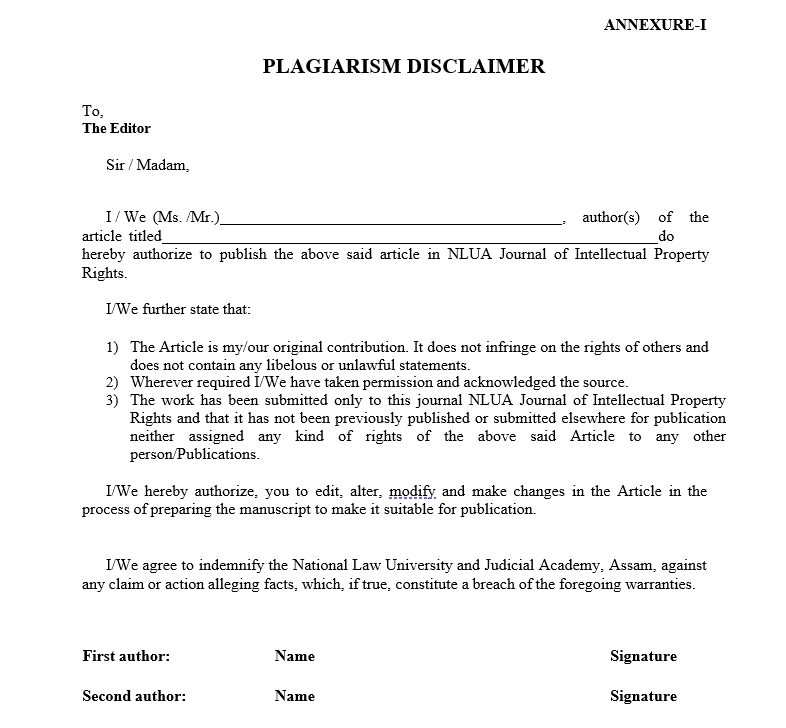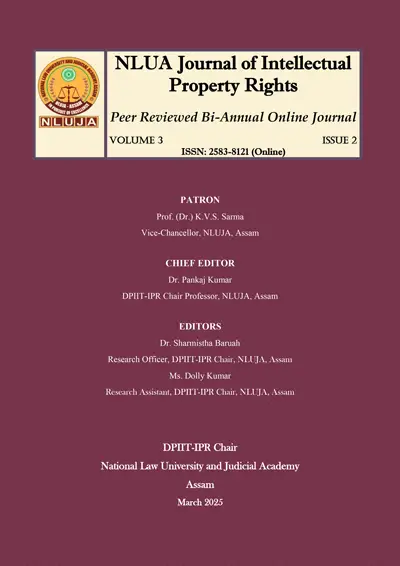NLUA Journal of Intellectual Property Rights
Ethics and Policy
ETHICAL POLICY
Reporting Standards
Authors of research paper should present an accurate account of the work performed as well as an objective discussion of its significance. Underlying data should be represented accurately in the paper. A paper should contain sufficient detail and references to permit others to replicate the work. Fraudulent or knowingly inaccurate statements constitute unethical behaviour and are unacceptable. Review and professional publication articles should also be accurate and objective, and editorial ‘opinion’ works should be clearly identified as such.
Data Access and Retention
Authors may be asked to provide the research data supporting their paper for editorial review and/or to comply with the open data requirements of the journal. Authors should be prepared to provide public access to such data, if practicable, and should be prepared to retain such data for a reasonable number of years after publication. Authors may refer to their journal’s Guide for Authors for further details.
Similarity checks for plagiarism shall exclude the following:
i. All quoted work reproduced with all necessary permission and/or attribution with correct citation.
ii. All references, footnotes, endnotes, bibliography, table of contents, preface, methods and acknowledgements.
iii. All generic terms, phrases, laws, standard symbols, mathematical formula and standard equations.
iv. Name of institutions, departments, etc.
Multiple, Redundant or Concurrent Publication
An author should not in general publish manuscripts describing essentially the same research in more than one journal of primary publication. Submitting the same manuscript to more than one journal concurrently constitutes unethical behaviour and is unacceptable as per self-plagiarism policy of UGC, 2021.
In general, an author should not submit for consideration in another journal a paper that has been published previously, except in the form of an abstract or as part of a published lecture or academic thesis or as an electronic preprint.
Publication of some kinds of articles (e.g. clinical guidelines, translations) in more than one journal is sometimes justifiable, provided certain conditions are met. The authors and editors of the journals concerned must agree to the secondary publication, which must reflect the same data and interpretation of the primary document. The primary reference must be cited in the secondary publication.
Confidentiality
Information obtained in the course of confidential services, such as refereeing manuscripts or grant applications, must not be used without the explicit written permission of the author of the work involved in these services.
Authorship of the Paper
Authorship should be limited to those who have made a significant contribution to the conception, design, execution, or interpretation of the reported study.
Where there are others who have participated in certain substantive aspects of the paper (e.g. language editing or medical writing), they should be recognized in the acknowledgements section.
Authors take collective responsibility for the work. Each individual author is accountable for ensuring that questions related to the accuracy or integrity of any part of the work are appropriately investigated and resolved.
Declaration of Competing Interests
All authors should disclose in their manuscript any financial and personal relationships with other people or organizations that could be viewed as inappropriately influencing (bias) their work.
All sources of financial support for the conduct of the research and/or preparation of the article should be disclosed, as should the role of the sponsor(s), if any, in study design; in the collection, analysis and interpretation of data; in the writing of the report; and in the decision to submit the article for publication. If the funding source(s) had no such involvement, then this should be stated.
Falsification and Fabrication
Papers with the inclusion of false or fabricated data will be returned to the contributors with a request for proper explanation. If no explanation is received or if the explanation provided is considered unsatisfactory, the journal will notify the authors’ institution and will not accept further submissions from the author.
(Note: Data falsification or fabrication refereed to image manipulation; omission of selected data; or making-up data sets etc.)
PEER REVIEW POLICY
The NLUA Journal of Intellectual Property Rights Editorial Team works untiringly to keep the Journal’s standards high. To ensure this, each manuscript is thoroughly screened in three stages:
1. Primary Screening: To make sure the submitted manuscripts meet general standards for suitability of work and that the conceptual and theoretical underpinnings of the paper are sound, a Primary Screening is carried out. The team also checks that the manuscript adheres to the ILI citation style, formatting, word limits, etc. at this stage.
2. Plagiarism Assessment: The manuscripts are then subjected to a plagiarism assessment; the maximum similarity index allowed upto 10% (UGC standards). Before submitting, the Authors are requested to assure that this criterion must be met.
3. Peer Review: The approved manuscripts are then sent to experts for blind peer review after passing the aforementioned two tests. The experts assess the manuscripts according to certain parameters, such as relevancy of topic, depth of analysis, coherence, etc. The review reports are then sent to the authors.
Depending on the number of submissions, the entire process takes generally 4 to 8 months. If changes need to be made to the original manuscript, the authors will be informed at the conclusion of each stage. The results of the aforementioned three tests will determine whether a manuscript is finally accepted or rejected.
PLAGIARISM POLICY
The authors should ensure that they have written entirely original work, and if the authors have used the work and/or words of others that it has been appropriately acknowledged, cited, quoted and permission has been obtained where necessary. Authors should cite publications that have influenced the reported work and that give the work appropriate context within the larger scholarly record. Information obtained privately, as in conversation, correspondence, or discussion with third parties, must not be used or reported without explicit, written permission from the source.
Kindly note that all submissions will mandatorily undergo plagiarism test. Article should contain a disclaimer to the effect that the submitted paper is original and is neither been published nor under consideration for publication elsewhere (Annexure I attached).
Plagiarism takes many forms, from ‘passing off’ another’s paper as the author’s own paper, to copying or paraphrasing substantial parts of another’s paper (without attribution), to claiming results from research conducted by others. Plagiarism in all its forms constitutes unethical behaviour and is unacceptable.
All submissions shall meet 10% similarity and all other requirements as per the University Grants Commission (Promotion of Academic Integrity and Prevention of Plagiarism in Higher Education Institutions) Regulations, 2018.
LICENSE AND SELF-ARCHIVING POLICY
NLUA Journal of Intellectual Property Rights is a fully open access journal, and all articles are published in the journal under an open access license i.e. CC BY 4.0 (https://creativecommons.org/licenses/by/4.0/), which allows copying, distributing, displaying, performing, and making derivates of the work under the condition of attribution.
More information about Creative Commons licenses is available on the Creative Commons website (https://creativecommons.org/)
Prior to acceptance for publication in the journal, authors retain the right to make their original version of the article available on their own personal website and/or that of their employer and/or in free public servers of original version articles in their subject area, provided that, upon acceptance, they acknowledge that the article has been accepted for publication as follows:
This article has been accepted for publication/ published in [Journal Title] Published by National Law University and Judicial Academy, Assam.

